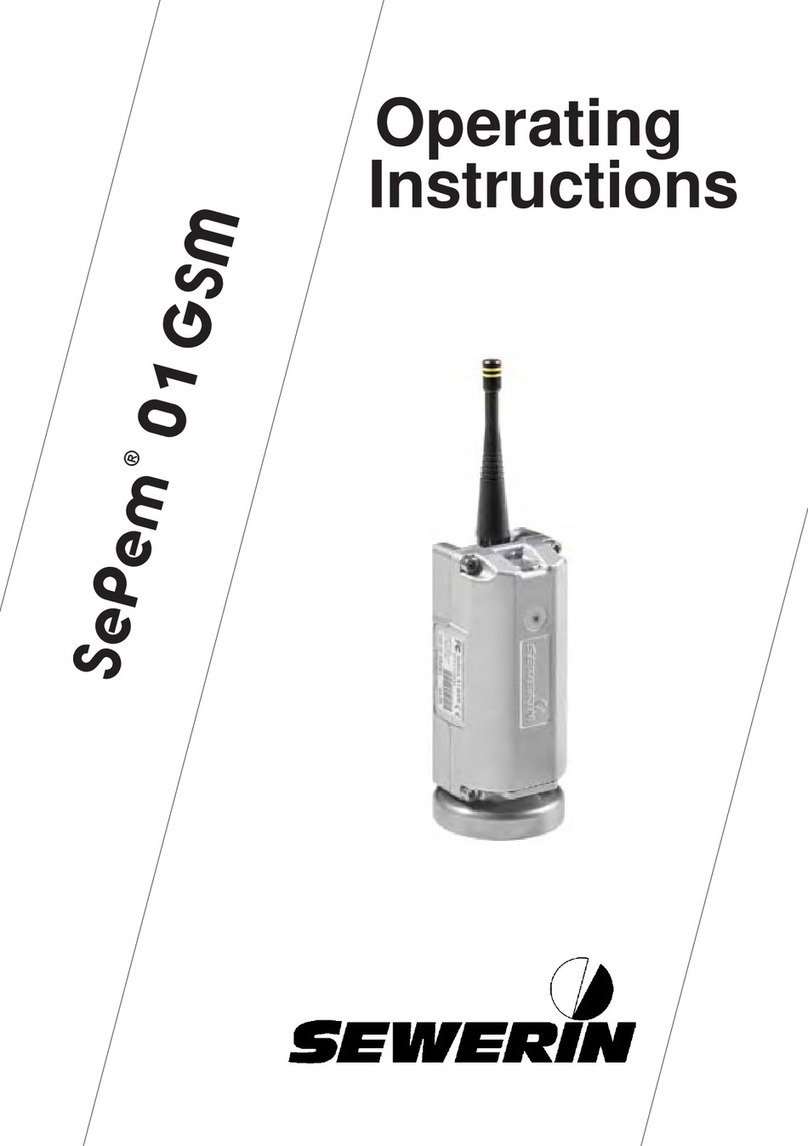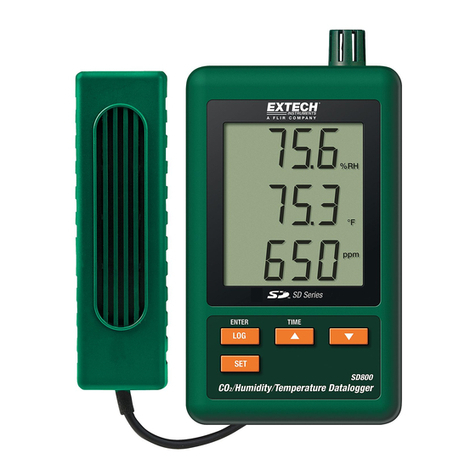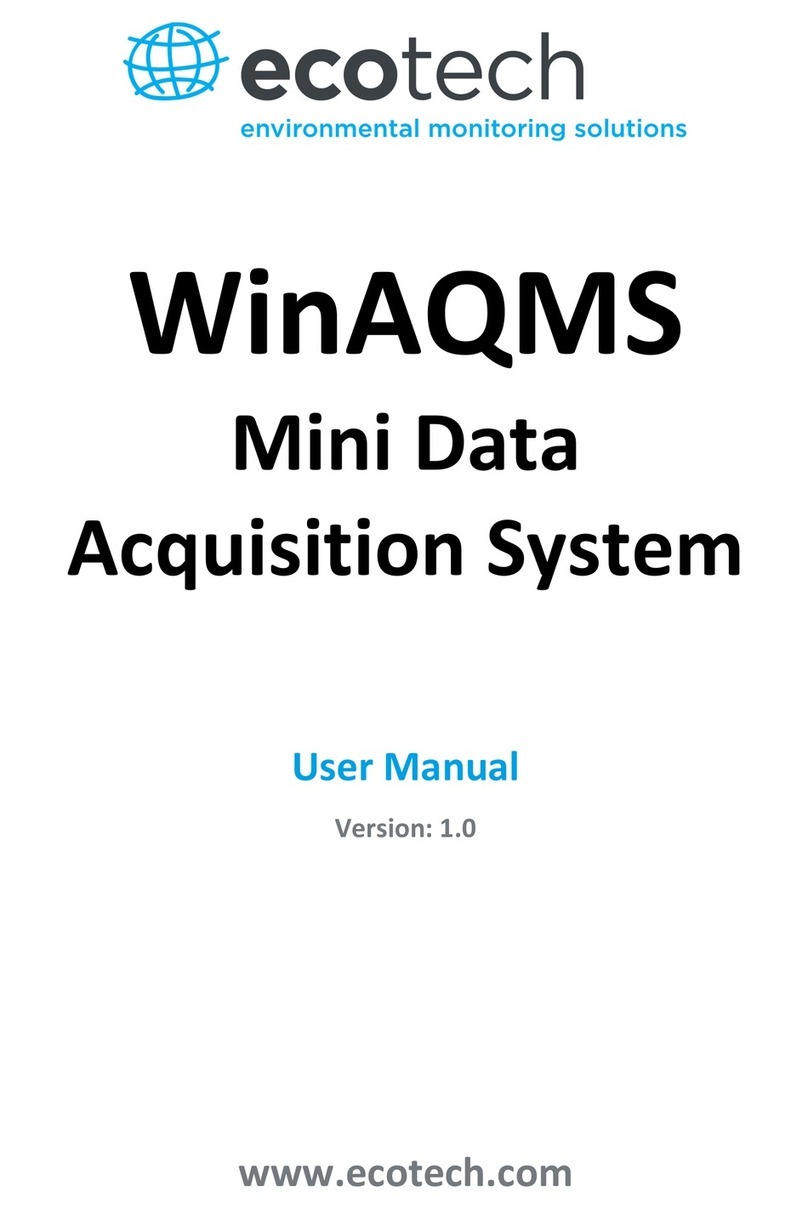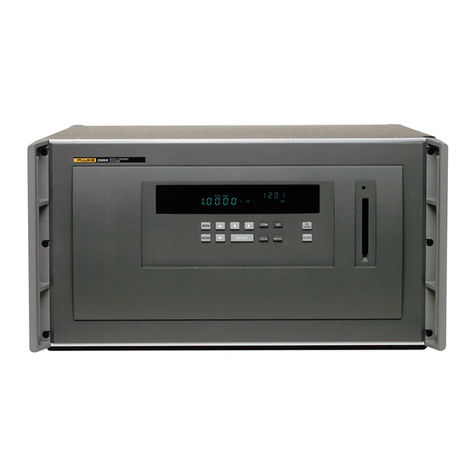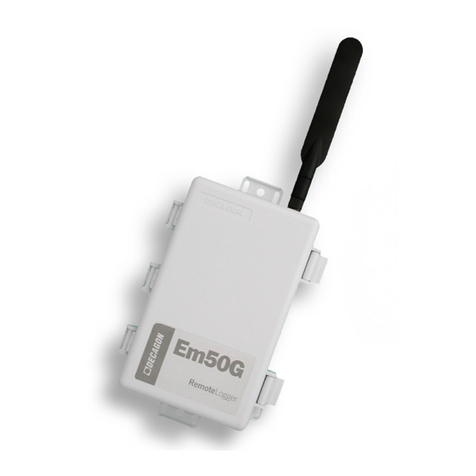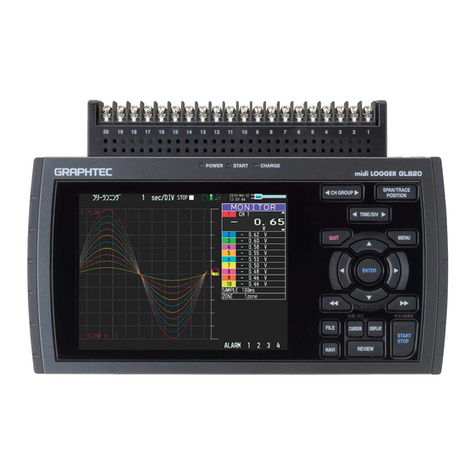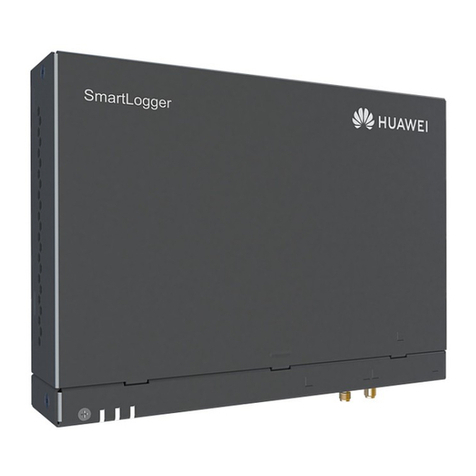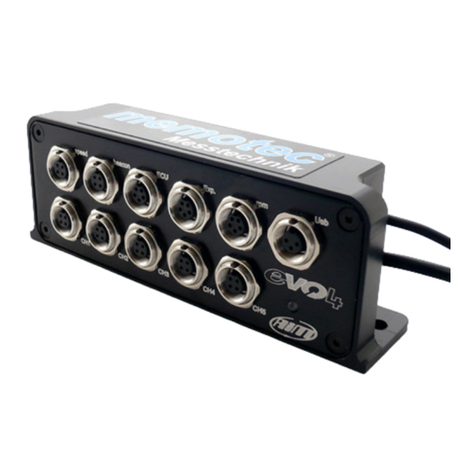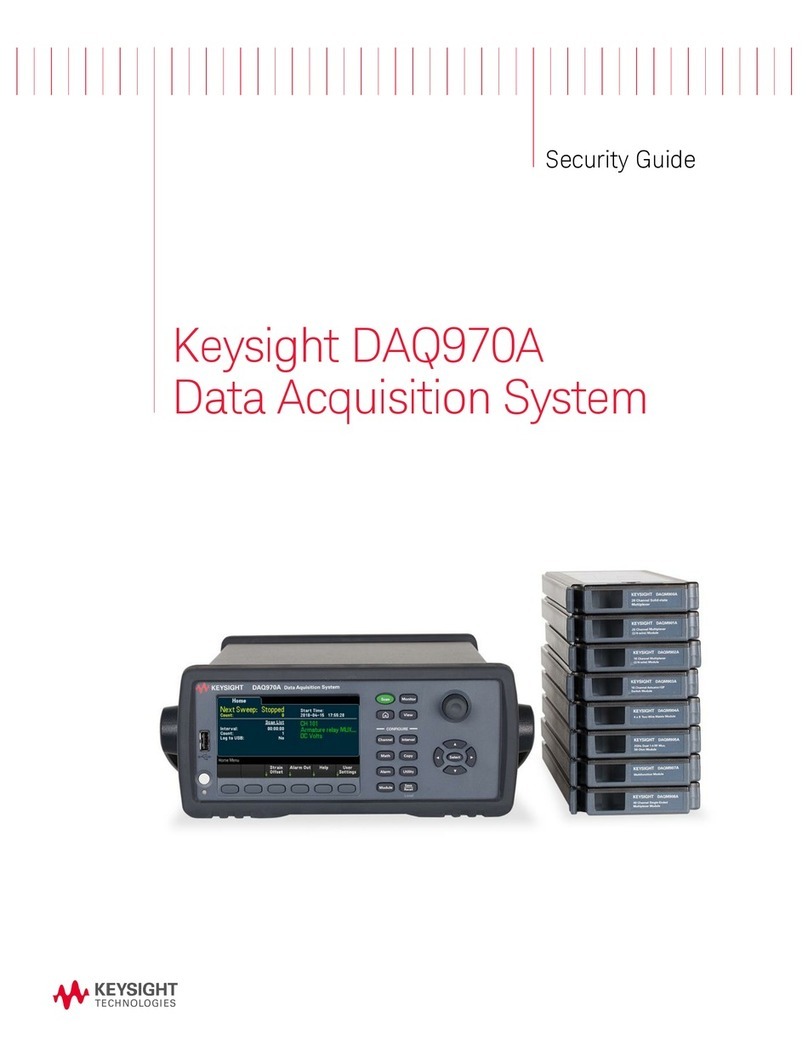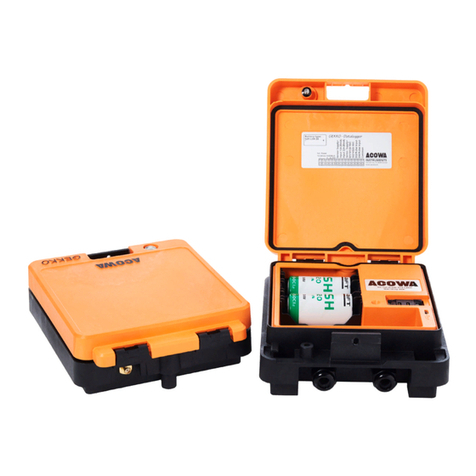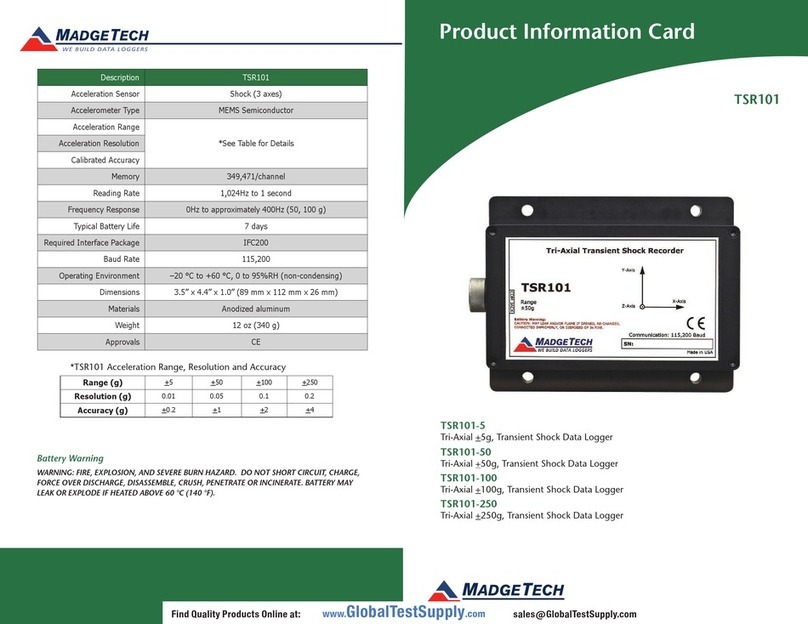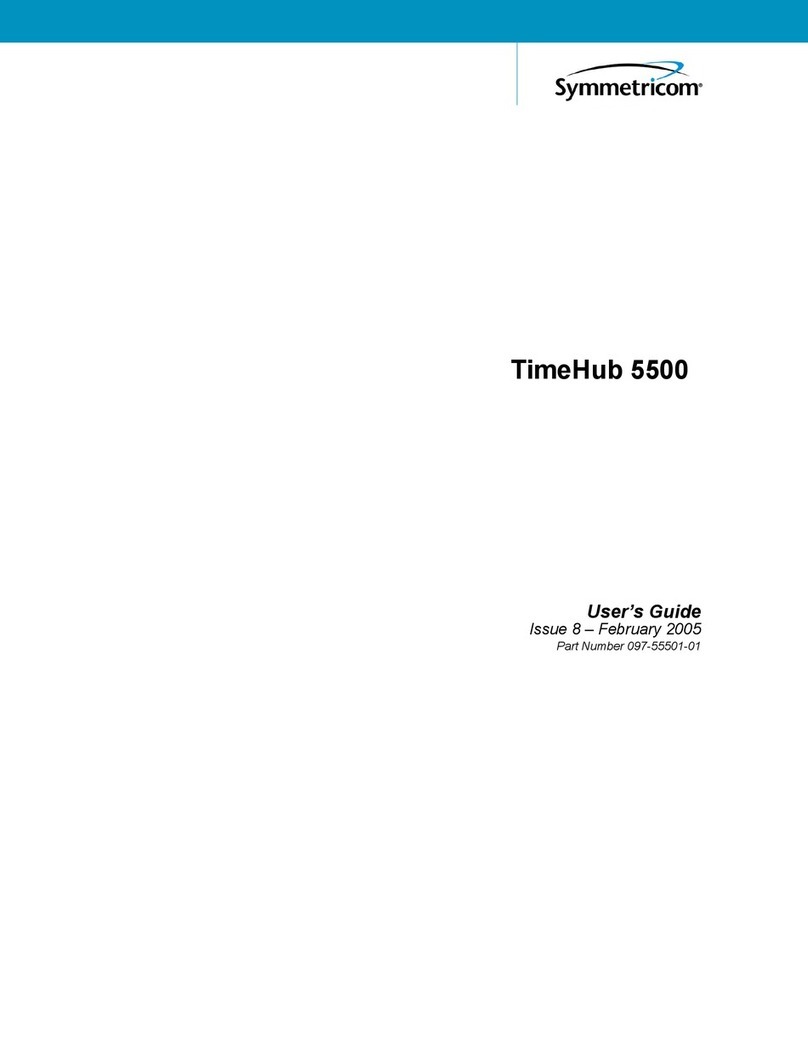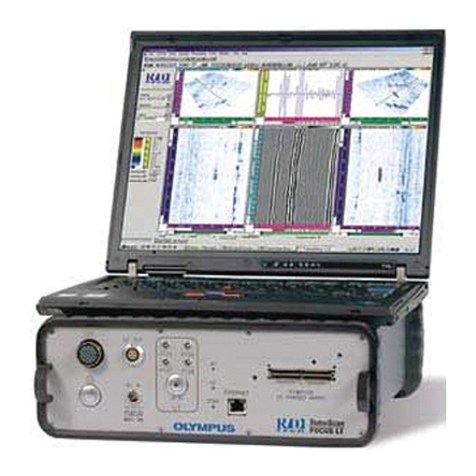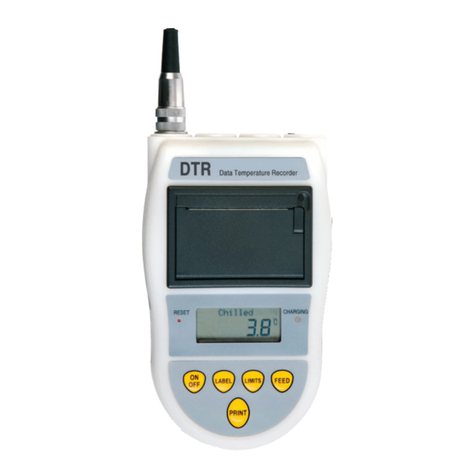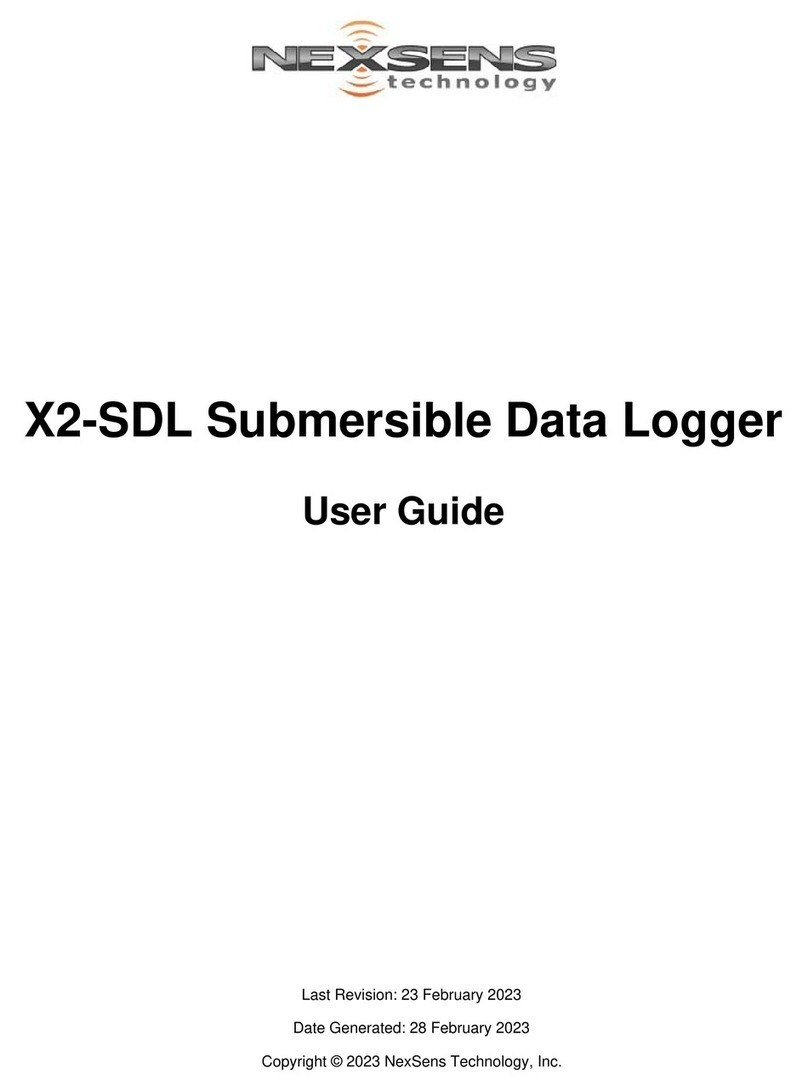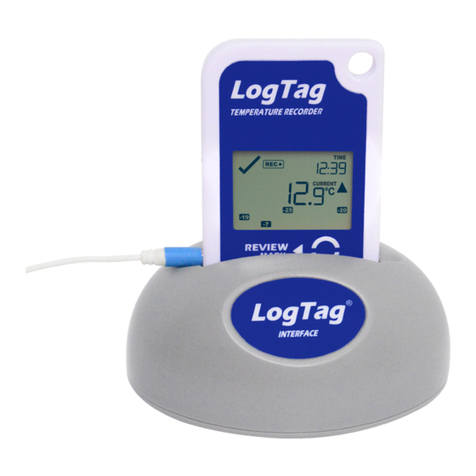sewerin SePem 100 User manual

24.03.2017 a – 107336 – en
SePem®
SePem®100/150
SePem®01 Master
Operating instructions

Logger SePem®100/150
Aerial
Bridge with strap
Antenna connector
Activation switch
Magnet
Fig. 1: SePem 100 logger (left) and
SePem 150 logger without aerial (top right) and with
aerial (bottom right)

SePem®01 Master
Connector
Buzzer
ON/OFF key
Aerial
Function keys F1, F2, F3
Fig. 2: SePem 01 Master without aerial (top) and with aerial (bottom)
Signal light
Display
USB port
Connection for power supply
Jog dial
Supporting bracket

Information about this document
The warnings and notes in the document mean the following:
ACAUTION!
Risk of personal injury. Can result in injury or a risk to
health.
NOTICE!
Risk of damage to property.
Note:
Tips and important information.
Enumerated lists (numbers, letters) are used for:
● instructions that must be followed in a specic sequence
Bullet lists (bullet points, dashes) are used for:
●lists
●Instructions comprising only one action
Numbers enclosed by forward slashes /.../ refer to referenced doc-
uments.

I
Contents Page
1 Introduction .............................................................................1
2 General.....................................................................................2
2.1 Warranty....................................................................................2
2.2 Intended use .............................................................................2
2.3 General safety information ........................................................3
3 SePem system.........................................................................4
3.1 System components..................................................................4
3.2 Mobile operation versus stationary operation ...........................4
3.3 Operating principle ....................................................................5
3.3.1 Monitoring procedure (overview)............................................5
3.3.2 Radio frequency for data transmission...................................5
3.3.3 Principles of leak detection ....................................................6
3.3.3.1 Leak detection in mobile mode ...........................................6
3.3.3.2 Leak detection in stationary mode ......................................6
4 SePem 100/150 loggers ..........................................................7
4.1 Functionality and construction...................................................7
4.2 Specifying a device number (optional) ......................................8
4.3 Installing the logger at the measurement location.....................8
4.3.1 Suitable installation locations .................................................8
4.3.2 Distance between two loggers (recommended).....................9
4.3.3 Preparing the logger...............................................................9
4.3.3.1 Screwing on the magnet .....................................................9
4.3.3.2 Screwing on the aerial (SePem 150)................................10
4.3.3.3 Initial programming of the logger.......................................10
4.3.4 Installing the logger ..............................................................12
4.3.4.1 General installation instructions ........................................12
4.3.4.2 Using installation adapters................................................13
5 SePem 01 Master...................................................................14
5.1 Functionality and construction.................................................14
5.2 Using the Master in vehicles ...................................................15
5.3 Power supply...........................................................................16
5.3.1 Options.................................................................................16
5.3.2 Special features of rechargeable batteries...........................16
5.3.3 Changing the battery............................................................16
5.3.4 External power supply..........................................................17
5.4 Operation ................................................................................18

II
Contents Page
5.4.1 Keys and jog dial..................................................................18
5.4.2 Standard functions ...............................................................19
5.4.3 Warning prompts..................................................................19
5.4.4 Entering text .........................................................................20
5.4.5 Scrolling in charts.................................................................22
5.5 Firmware menus and Master – logger interaction...................23
5.5.1 Main menu (overview)..........................................................23
5.5.2 Patrol....................................................................................24
5.5.2.1 Requirements for a successful patrol................................25
5.5.2.2 Patrol procedure (overview)..............................................26
5.5.2.3 Analysing measurement result readouts...........................27
5.5.2.4 Extended data set .............................................................28
5.5.2.5 Graphics............................................................................30
5.5.3 Logger communication.........................................................32
5.5.3.1 Logger data features.........................................................32
5.5.3.2 Measurement result features ............................................33
5.5.3.3 Multipleloggers(loggerconguration)..............................33
5.5.3.4 Single logger .....................................................................37
5.5.3.5 Transmitting data to the loggers........................................40
5.5.3.6 Standard settings ..............................................................43
5.5.4 Logger management ............................................................44
5.5.4.1 Logger database ...............................................................44
5.5.4.2 Patrol lists..........................................................................47
5.5.5 Master settings.....................................................................48
5.5.6 Master info ...........................................................................51
6 Troubleshooting ....................................................................52
6.1 Problems with the logger.........................................................52
6.2 Problems with the Master........................................................52
6.3 Problems with the Master – logger radio connection ..............53
6.3.1 Check the radio connection..................................................54
6.3.2 Improving the radio connection ............................................55
6.4 Other problems .......................................................................55
7 Appendix................................................................................56
7.1 Specicationsandpermittedoperatingconditions..................56
7.1.1 SePem 100 and SePem 150 loggers...................................56
7.1.2 SePem 01 Master ................................................................57
7.2 Measurement types (overview) ...............................................59
7.3 Menu structure ........................................................................60
7.4 Display symbols (Master)........................................................61

III
Contents Page
7.5 Terminology and general abbreviations ..................................63
7.6 Abbreviationsinthermware..................................................65
7.7 Accessories and consumables................................................66
7.8 Advice on disposal ..................................................................67
8 Index.......................................................................................68

1
1 Introduction
1 Introduction
The SePem system is used for the early detection of leaks in
water pipe networks.
The SePem 100 logger is ideal for mobile use as the aerial of the
logger is integrated in the housing.
The SePem 150 logger is designed especially for stationary
operation, i.e. for use in the continuous monitoring of water pipe
networksat xedmeasurementlocations overlong periodsof
time (several years).
The SePem 01 Master programming and read-out unit allows the
system to be operated without the need for a computer.
SePem is a prelocation system. Indications that a leak is present
must,therefore,alwaysbeveriedusinganappropriatemethod
(e.g. correlation).
Note:
These operating instructions describe the SePem system. All
descriptions refer to the system as delivered (factory settings).
The manufacturer reserves the right to make changes.

2
2 General
2 General
2.1 Warranty
The following instructions must be complied with in order for any
warranty to be applicable regarding functionality and safe oper-
ation of this equipment.
●Read these operating instructions prior to operating the product.
●Use the product only as intended.
●Repairs and maintenance must only be carried out by special-
ist technicians or other suitably trained personnel. Only spare
parts approved by Hermann Sewerin GmbH may be used when
performing repairs.
● Changesormodicationstothisproductmayonlybecarried
out with the approval of Hermann Sewerin GmbH.
●Use only Hermann Sewerin GmbH accessories for the product.
Hermann Sewerin GmbH shall not be liable for damages resulting
from the non-observance of this information. The warranty condi-
tions of the General Terms and Conditions ("AGB") of Hermann
Sewerin GmbH are not affected by this information.
In addition to the warnings and other information in these Oper-
ating Instructions, always observe the generally applicable safety
and accident prevention regulations.
The manufacturer reserves the right to make technical changes.
2.2 Intended use
SePem is a measurement data recording and evaluation system.
The system is designed for use in the stationary and mobile moni-
toring of water pipe networks. It must only be operated by suitably
qualiedemployees(skilledstaff,specialistsandtechnicians)of
water supply companies.
The system is only suitable for use in industrial and commercial
applications. All applicable safety regulations and accident pre-
vention regulations must be complied with when using the system.
Detailed information on appropriate operating conditions for the
system and its components at the place of installation are pro-
vided in Section 7.1.

3
2 General
2.3 General safety information
This product was manufactured in keeping with all binding legal
and safety regulations. It corresponds to the state-of-the-art and
conforms to EC requirements. The product is safe to operate
when used for its intended purpose.
However, if you handle the product improperly or not as intended,
the product may present a risk to persons and property. For this
reason, always observe the following safety information.
●Do not make any changes to the product.
●Never open the equipment housing. (Does not apply to the
battery compartment of the SePem 01 Master.)
●The logger contains a powerful magnet. Persons with heart
pacemakers must avoid close proximity to the device.
●The logger must be kept away from magnetic storage media
(diskettes, hard drives, credit cards, etc.), monitors (PC, TV)
and clocks.
●The logger batteries must only be replaced by SEWERIN Ser-
vice or by other suitably trained personnel.
●Ensure that no dirt or moisture can get into the connections on
any of the devices.
●Never carry a unit by its aerial.
●Never bend, kink or cut the aerial of the units.
●Always observe the permitted operating and storage temper-
atures.
●Do not expose the SePem 01 Master to any source of moisture
that could enter the device.

4
3 SePem system
3 SePem system
3.1 System components
The SePem system (SePem for short) comprises:
●SePem 100 / SePem 150 logger (logger for short (see Sec-
tion 4)
for recording measurement data
●SePem 01 Master, Master for short (see Section 5)
for programming loggers and collecting and evaluating meas-
urement results from the loggers
A single Master can be used to manage up to 400 loggers. A
wide range of accessories is available for both the loggers and
the Master (see Section 7.7).
3.2 Mobile operation versus stationary operation
The aim of stationary applications is to provide continuous mon-
itoring over a large area of water pipe networks, whereas mobile
applications of the system are designed for regular checks carried
out over smaller areas.
Mobile operation represents a cost-effective alternative to station-
ary operation as only a limited number of loggers are necessary.
The loggers will typically be installed for a few days to provide
comprehensive coverage in the monitoring area. The measure-
ment data that is recorded can then be read out and evaluated at
regular intervals. Monitoring of the area is completed when any
leaks detected are repaired. The loggers can then be moved to
the next monitoring area.
The SePem 100 logger is ideal for mobile use because the aerial
in the logger is integrated in the housing

5
3 SePem system
3.3 Operating principle
3.3.1 Monitoring procedure (overview)
The system works according to the following principle:
1. Programtheloggerforthersttime(seeSection 5.5.3).
For each individual logger, specify where it will be used to
gather measurement data and at what times.
2. Install the logger at the measurement location (see Sec-
tion 4.3)
3. The logger works autonomously, i.e. it records data at the
predenedtimes.
4. Read out the measurement data using the Master (see Sec-
tion 5.5.2)
The logger will transmit the measurement results at regular
intervals within a prescribed period of time. The period of time
isreferredtoastheradiotimeframeandisspeciedduring
programming.
To read out the data, the user must take the Master into the ra-
dio transmission range of the logger. The measurement results
will be transferred automatically from the logger to the Master
as soon as the user enters the radio transmission range.
It is also possible to read out additional information relating
to the logger itself and to display a chart of the measurement
(Graphics).
5. Evaluate the measurement results immediately or later with the
Master (see Section 5.5.2.2 – Section 5.5.2.4, Section 5.5.4)
3.3.2 Radio frequency for data transmission
When it is installed in a pit, the logger transmits its data out of
this pit. The range of the radio signals is heavily dependent on
the shielding effects of the shaft, especially the cover.
As a general rule, the radio signals can be expected to have a
range of 30 – 70 m from the installation position. The range may
be extended up to 100 – 200 m for plastic covers.

6
3 SePem system
3.3.3 Principles of leak detection
Various methods are used to detect a leak.
Note:
Leak alerts will not be issued if there is background noise (fre-
quency 50Hz or 100Hz).
Please refer also to the information on interpreting measurement
results and leak alerts in Section 5.5.2.3 – Section 5.5.2.5.
3.3.3.1 Leak detection in mobile mode
In order to determine whether or not the measurement data re-
corded by a logger used as a mobile unit indicates a leak, an
alarmthresholdisspeciedintheMaster (absolute value). If the
minimumnoiselevelmeasuredexceedsthespeciedthreshold
value then the operator will be alerted to a leak.
The level that is set for the alarm threshold will depend on the ma-
terial of the pipe in the vicinity of the logger. It is therefore possible
to set the alarm threshold in the Master for each individual Logger.
3.3.3.2 Leak detection in stationary mode
When used in a stationary application, the leak detection method
employed by the system is based on a mathematical relationship
that compares measurement values at different points in time
(detection of variations). The following points must be taken into
consideration when evaluating results:
●The water pipe network must be leak-free before setting up the
system for stationary use.
●Only leaks that occur after the monitoring has been started
will be detected.
●A leak alert will only be issued after three measurements have
beentakensincetherstoccurrenceoftheleak;thisavoids
falsedetectionofleaksduetoshort-termuctuations.
●It is possible that false leak alerts may be issued because of
externalinuences(e.g.prolongedheavyrain).

7
4 SePem 100/150 loggers
4 SePem 100/150 loggers
4.1 Functionality and construction
The SePem 100 and SePem 150 loggers record sound. They
can gather and save data from water pipe networks. Data is ex-
changed with the Master by radio.
Youwillndanoverviewwiththenamesoftheloggerpartsinside
the front cover (Fig. 1).
Aerial
The only difference between the SePem 100 and SePem 150
loggers is their aerial. The aerial of the SePem 100 logger is in-
tegrated in its housing. The aerial of the SePem 150 logger can
be unscrewed.
Strap
A safety rope can be attached to the logger strap to make instal-
lation and removal at deep locations easier.
Mounting
The unit can be mounted on metal objects using magnets. If it
is necessary to monitor a plastic pipe then the logger must be
attachedtothettings.
Power supply
The power supply is provided by a permanently installed lithium
battery that has a guaranteed lifetime of several years under
normal operating conditions.

8
4 SePem 100/150 loggers
4.2 Specifying a device number (optional)
Every Logger is assigned an 11 digit serial number by the manu-
facturer before shipping. In order to simplify the job of managing
the loggers (in the Master software and at the measurement
location) it is possible to assign each unit a device number. Any
number may be selected, up to a maximum of four digits. This
number could, for example, be the same as the last four digits
of the serial number.
1. It is advisable to decide on a format that can be used as the
device number for all loggers.
2. Each logger should be labelled with the device number.
3. The device numbers must be saved with the corresponding
serial number in the Master (see Section 5.5.4.1).
4.3 Installing the logger at the measurement location
4.3.1 Suitable installation locations
The logger can be mounted on:
●Pipes
●Fittings (slide gates, underground hydrants, above-ground
hydrants)
Note:
Only attach the logger to above-ground hydrants if it is possible
to protect the device against theft and vandalism.
The units can be installed both in water pipe networks construct-
ed from metal and plastic piping. Please note that if installed in
plastic water pipe networks:
●The logger cannot be mounted directly on the pipe, instead it
hastobeattachedtoatting.
●On plastic piping sound is not transmitted as well as in metal
pipework systems.

9
4 SePem 100/150 loggers
4.3.2 Distance between two loggers (recommended)
The following spacing between each logger is recommended to
allow systematic monitoring of an area:
Water pipe net-
work made of
Fitting logger
to
Recommended distance
between two loggers
Metal Fitting 300 – 500 m (mobile)
500 m (stationary)
Plastic Fitting 50 – 100 m
For highly intermeshed water pipe networks, the distance between
loggers may have to be reduced accordingly.
4.3.3 Preparing the logger
The preparatory work required for each logger includes:
●Screwing the magnet onto the logger
●Screwing the aerial onto the logger (SePem 150 only)
●Initial programming of the logger
4.3.3.1 Screwing on the magnet
The magnet must be screwed onto the logger to ensure that the
logger is secure at the place of installation.
1. Please ensure that the threads on both the logger and the
magnet are clean.
2. Screw the magnet on hand-tight.

10
4 SePem 100/150 loggers
4.3.3.2 Screwing on the aerial (SePem 150)
Note:
The aerial must only be screwed onto the SePem 150 logger.
The aerial of the SePem 100 logger is integrated in its housing.
The logger and the aerial are connected using a TNC plug-in
connector. The antenna can be screwed directly into the threaded
antenna connector.
1. Please ensure that the contacts on both the logger and the
aerial are clean and dry.
2. Screw the aerial onto the aerial connector.
Hand-tighten the aerial to ensure that the unit is sealed and
to guarantee a good radio signal.
NOTICE! Risk of damage!
There must be no mechanical stress on the internal contacts of
the TNC plug-in connector.
●Only tighten the aerial by hand.
●Do not use any tools.
4.3.3.3 Initial programming of the logger
Before installing the logger at the measurement location it must be
programmed, i.e. data relating to measurement times, measure-
ment duration and the radio time frame etc. must be transferred
from the Master to the logger. Radio contact between the two
devices must be established to carry out programming.
Note:
Each logger has to be programmed individually.

11
4 SePem 100/150 loggers
1. First prepare the Master for programming the loggers (see
Section 5.5.3, in particular Section 5.5.3.3).
2. Activate the logger by moving a magnet over the activation
switch. Fig. 3 shows the direction of movement to be used.
You can, for example, use the magnet of another logger.
The logger will remain ready to receive information for one
minute after activation.
Fig. 3: Activating the logger:
Relief of the activation switch on the housing (left)
Direction of movement of magnet (right)
3. Move the Master into the transmission range of the logger.
Transfer the data (see Section 5.5.3.5).
If a radio connection is not established between the Master and
the logger within the available time frame then the logger will au-
tomatically switch off again and must be reactivated as required.
Note:
If the device settings for the logger are changed in the course of
further work then the radio time frame can be used to transfer the
relevant data. The logger, therefore, does not have to be activated
manually every time.

12
4 SePem 100/150 loggers
4.3.4 Installing the logger
The logger is secured at the installation location using the magnet.
Note:
Note Section 4.3.1 and Section 4.3.2!
NOTICE! Damage possible from rough handling
The logger contains shock-sensitive components.
●Always place the logger carefully on the attachment point.
4.3.4.1 General installation instructions
●Use a safety rope if the attachment point is so deep that you
cannot set the logger down by hand. The safety rope is at-
tached to the strap.
The safety rope is available to buy as an accessory.
●Ensure that a good metal-to-metal contact is formed between
the logger magnet and the body to which it is attached.
It is important that structure-borne sound is not damped by dirt,
mud or rust. Clean the attachment point if necessary before
mounting the logger magnet.
●The aerial of the SePem 150 must not touch any metal parts
at the installation location.
●The SePem 150 aerial must remain straight and must not have
contact with any other object once the shaft cover is closed.
Allow for the required clearance.

13
4 SePem 100/150 loggers
4.3.4.2 Using installation adapters
Atsomeinstallationlocationsitisdifcultorimpossibletosecure
the logger vertically using its magnet. In this case an installation
adapter is recommended. The installation adapter is particularly
useful for installing loggers horizontally.
The installation adapter is available to buy as an accessory.
The installation adapter consists of a tilted stainless steel panel
with slot hole and a contact adapter (magnet). The contact adapter
can be moved along the slot hole until you have found the optimal
position for the installation location. The contact adapter is then
tightened with a square nut. The logger is docked to the short
piece of panel using its magnet (Fig. 4).
Fig. 4: Installation adapter with docked logger and various positions of
the contact adapter
This manual suits for next models
2
Table of contents
Other sewerin Data Logger manuals

